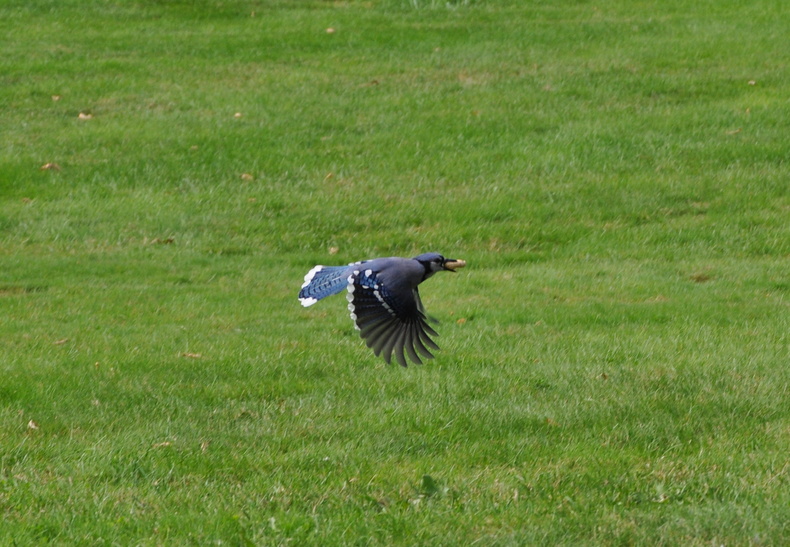As we harvest the last of the vegetables from our garden, I think about birds putting food aside for the winter. Hoarding food is a way for some land birds to tough it out in a northern winter. The benefits of not having to migrate are huge.
Black-capped chickadees are well known for their food-hoarding behavior.
Usually seeds are hoarded, although insects and spiders may be stored as well. Insects and spiders are prepared before storage by removing the head.
Chickadees readily cache sunflower seeds and pieces of suet from bird feeders. A chickadee removes the husk of a seed before caching it.
Chickadees do most of their hoarding in the fall, particularly in October and November.
The number of seeds stored is staggering. Over 1,000 items may be stored in a single day and, over the course of autumn, 50,000 to 80,000 spruce seeds may be cached.
Sites for food storage are varied. Typical hiding places are cracks or crevices in woody vegetation, under bits of bark (particularly birch bark), in clusters of conifer needles, in the ground and even in the snow.
Tufted titmice, members of the chickadee family, regularly hoard seeds.
Nuthatches, classified into their own family but closely related to chickadees, also store food for use at a later time.
In the winter of 1995-1996, I was doing some research on the effect of bird feeders on chickadees and nuthatches in a remote area east of Flagstaff Lake. To my surprise, a tufted titmouse (north of their current range) appeared at one of the feeders in December and continued to visit through March.
The titmouse was considerably more timid than the chickadees and nuthatches coming to the feeder.
On several occasions, I saw the titmouse watch a red-breasted nuthatch hoard a seed under the bark of a conifer. When the nuthatch left, the titmouse would come over and remove the seed from the hiding place. A clever thief!
The jay and crow family contains over 100 species, many of which store food.
Blue jays are energetic hoarders, storing acorns and other nuts but even invertebrates, small vertebrates or bits of meat. Favored storage sites are cracks and crevices of tree trunks, amid the needles of conifers and in loose soil.
A blue jay can carry up to five acorns at once to be stored. The acorns are swallowed and stored in the upper part of the esophagus. The acorns can then be regurgitated intact when a suitable hoarding site is found.
Gray jays, common in the mountains and the northern half of Maine, are unusual in their method of hoarding. Gray jays have enlarged salivary glands that secrete a very sticky, saliva.
This salivary glue is used to cement together food items, like insects and scraps of meat, into food packets measuring about 3/4 inch long and 3/8 inch wide. These packets are lodged into the bark or needles of conifers, where the saliva in the food packet dries, cementing the food into place.
Two members of the jay family from western North America, the pinon jay and Clark’s nutcracker, rely heavily on hoarding to get through the winter.
Both species store pine seeds, which they laboriously remove from the pinecones.
A single Clark’s nutcracker can store up to 100,000 seeds in the fall.
Both nutcrackers and pinon jays do not raid their hoarded seeds until most of the fall seed crop is depleted. One researcher has determined that up to 90 percent of the winter diet of pinon jays comes from stored seeds.
The largest members of the jay family, American crows and common ravens, store food as well. Stored items include carrion, mice, fish, frogs, salamanders and dung.
Most of the food stored by these two species is perishable and therefore must be recovered within a day or less after caching.
Of the 198 species of woodpeckers, only 10 are known to hoard food.
Downy woodpeckers and hairy woodpeckers are among those 10, but store food only infrequently. The champion hoarder among the woodpeckers is the acorn woodpecker.
Family groups of acorn woodpeckers excavate thousands of holes in a dead tree, called a granary.
Each hole takes about an hour to excavate. A woodpecker will fill the hole with an acorn. Some granaries have 50,000 holes, each filled with an acorn.
The family group defends the granary tree against all competitors seeking to use the acorns.
Shrikes store food in an interesting way. Small mammals or birds are killed and then impaled on a thorn or barbed wire fence for later consumption, hence the reason for calling these hoarders butcher birds.
Herb Wilson teaches ornithology and other biology courses at Colby College. He welcomes reader comments and questions at:
whwilson@colby.eduContributed photo
A blue jay flies away with a morsel in its mouth in a photo submitted by Alice Bouchard of Westbrook, who says she enjoys feeding the birds every day. Blue jays are energetic food hoarders in the fall.
Send questions/comments to the editors.



Success. Please wait for the page to reload. If the page does not reload within 5 seconds, please refresh the page.
Enter your email and password to access comments.
Hi, to comment on stories you must . This profile is in addition to your subscription and website login.
Already have a commenting profile? .
Invalid username/password.
Please check your email to confirm and complete your registration.
Only subscribers are eligible to post comments. Please subscribe or login first for digital access. Here’s why.
Use the form below to reset your password. When you've submitted your account email, we will send an email with a reset code.